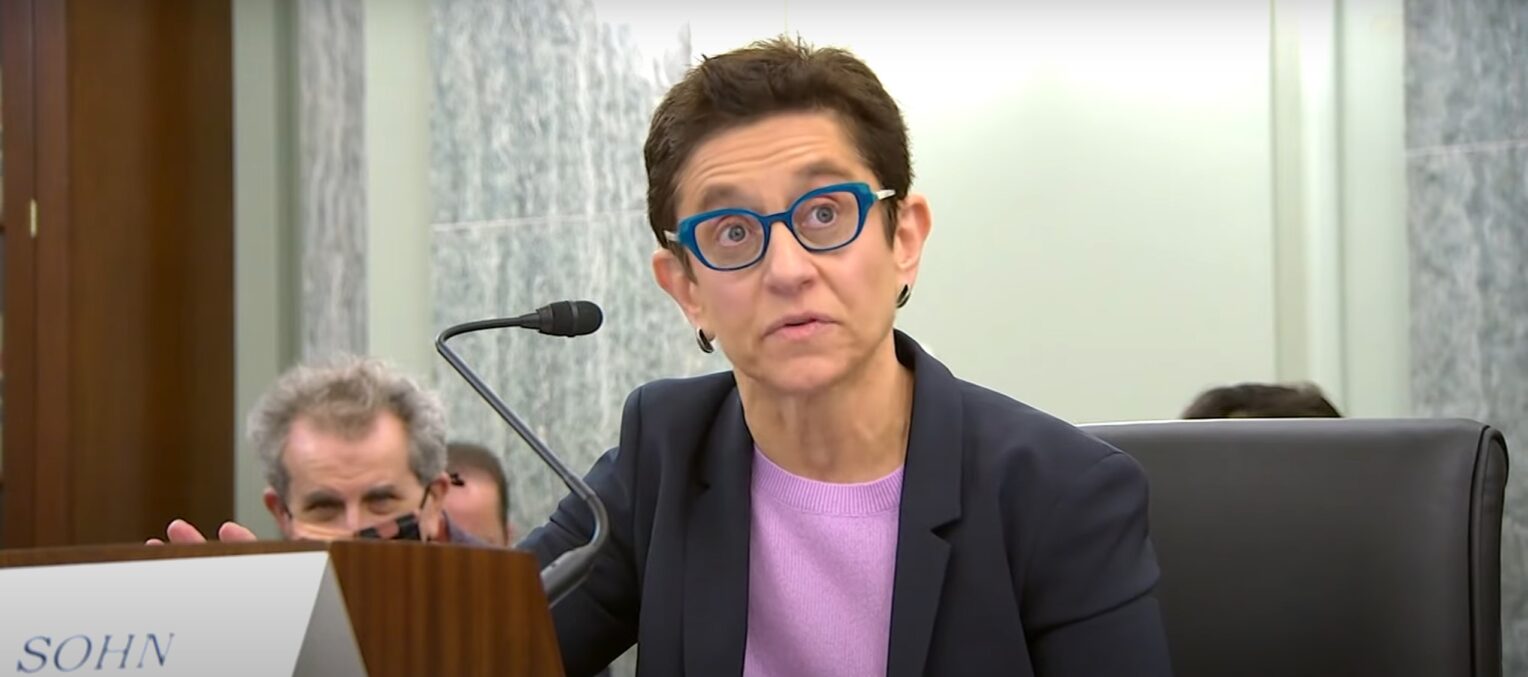
President Joe Biden’s nomination of Gigi Sohn to serve on the Federal Communications Commission (FCC)—scheduled for a second hearing before the Senate Commerce Committee Feb. 9—has been met with speculation that it presages renewed efforts at the FCC to enforce net neutrality. A veteran of tech policy battles, Sohn served as counselor to former FCC Chairman Tom Wheeler at the time of the commission’s 2015 net-neutrality order.
The political prospects for Sohn’s confirmation remain uncertain, but it’s probably fair to assume a host of associated issues—such as whether to reclassify broadband as a Title II service; whether to ban paid prioritization; and whether the FCC ought to exercise forbearance in applying some provisions of Title II to broadband—are likely to be on the FCC’s agenda once the full complement of commissioners is seated. Among these is an issue that doesn’t get the attention it merits: rate regulation of broadband services.
History has, by now, definitively demonstrated that the FCC’s January 2018 repeal of the Open Internet Order didn’t produce the parade of horribles that net-neutrality advocates predicted. Most notably, paid prioritization—creating so-called “fast lanes” and “slow lanes” on the Internet—has proven a non-issue. Prioritization is a longstanding and widespread practice and, as discussed at length in this piece from The Verge on Netflix’s Open Connect technology, the Internet can’t work without some form of it.
Indeed, the Verge piece makes clear that even paid prioritization can be an essential tool for edge providers. As we’ve previously noted, paid prioritization offers an economically efficient means to distribute the costs of network optimization. As Greg Sidak and David Teece put it:
Superior QoS is a form of product differentiation, and it therefore increases welfare by increasing the production choices available to content and applications providers and the consumption choices available to end users…. [A]s in other two-sided platforms, optional business-to-business transactions for QoS will allow broadband network operators to reduce subscription prices for broadband end users, promoting broadband adoption by end users, which will increase the value of the platform for all users.
The Perennial Threat of Price Controls
Although only hinted at during Sohn’s initial confirmation hearing in December, the real action in the coming net-neutrality debate is likely to be over rate regulation.
Pressed at that December hearing by Sen. Marsha Blackburn (R-Tenn.) to provide a yes or no answer as to whether she supports broadband rate regulation, Sohn said no, before adding “That was an easy one.” Current FCC Chair Jessica Rosenworcel has similarly testified that she wants to continue an approach that “expressly eschew[s] future use of prescriptive, industry-wide rate regulation.”
But, of course, rate regulation is among the defining features of most Title II services. While then-Chairman Wheeler promised to forebear from rate regulation at the time of the FCC’s 2015 Open Internet Order (OIO), stating flatly that “we are not trying to regulate rates,” this was a small consolation. At the time, the agency decided to waive “the vast majority of rules adopted under Title II” (¶ 51), but it also made clear that the commission would “retain adequate authority to” rescind such forbearance (¶ 538) in the future. Indeed, one could argue that the reason the 2015 order needed to declare resolutely that “we do not and cannot envision adopting new ex ante rate regulation of broadband Internet access service in the future” (¶ 451)) is precisely because of how equally resolute it was that the Commission would retain basic Title II authority, including the authority to impose rate regulation (“we are not persuaded that application of sections 201 and 202 is not necessary to ensure just, reasonable, and nondiscriminatory conduct by broadband providers and for the protection of consumers” (¶ 446)).
This was no mere parsing of words. The 2015 order takes pains to assert repeatedly that forbearance was conditional and temporary, including with respect to rate regulation (¶ 497). As then-Commissioner Ajit Pai pointed out in his dissent from the OIO:
The plan is quite clear about the limited duration of its forbearance decisions, stating that the FCC will revisit them in the future and proceed in an incremental manner with respect to additional regulation. In discussing additional rate regulation, tariffs, last-mile unbundling, burdensome administrative filing requirements, accounting standards, and entry and exit regulation, the plan repeatedly states that it is only forbearing “at this time.” For others, the FCC will not impose rules “for now.” (p. 325)
For broadband providers, the FCC having the ability even to threaten rate regulation could disrupt massive amounts of investment in network buildout. And there is good reason for the sector to be concerned about the prevailing political winds, given the growing (and misguided) focus on price controls and their potential to be used to stem inflation.
Indeed, politicians’ interest in controls on broadband rates predates the recent supply-chain-driven inflation. For example, President Biden’s American Jobs Plan called on Congress to reduce broadband prices:
President Biden believes that building out broadband infrastructure isn’t enough. We also must ensure that every American who wants to can afford high-quality and reliable broadband internet. While the President recognizes that individual subsidies to cover internet costs may be needed in the short term, he believes continually providing subsidies to cover the cost of overpriced internet service is not the right long-term solution for consumers or taxpayers. Americans pay too much for the internet – much more than people in many other countries – and the President is committed to working with Congress to find a solution to reduce internet prices for all Americans. (emphasis added)
Senate Majority Leader Chuck Schumer (D-N.Y.) similarly suggested in a 2018 speech that broadband affordability should be ensured:
[We] believe that the Internet should be kept free and open like our highways, accessible and affordable to every American, regardless of ability to pay. It’s not that you don’t pay, it’s that if you’re a little guy or gal, you shouldn’t pay a lot more than the bigshots. We don’t do that on highways, we don’t do that with utilities, and we shouldn’t do that on the Internet, another modern, 21st century highway that’s a necessity.
And even Sohn herself has a history of somewhat equivocal statements regarding broadband rate regulation. In a 2018 article referencing the Pai FCC’s repeal of the 2015 rules, Sohn lamented in particular that removing the rules from Title II’s purview meant losing the “power to constrain ‘unjust and unreasonable’ prices, terms, and practices by [broadband] providers” (p. 345).
Rate Regulation by Any Other Name
Even if Title II regulation does not end up taking the form of explicit price setting by regulatory fiat, that doesn’t necessarily mean the threat of rate regulation will have been averted. Perhaps even more insidious is de facto rate regulation, in which agencies use their regulatory leverage to shape the pricing policies of providers. Indeed, Tim Wu—the progenitor of the term “net neutrality” and now an official in the Biden White House—has explicitly endorsed the use of threats by regulatory agencies in order to obtain policy outcomes:
The use of threats instead of law can be a useful choice—not simply a procedural end run. My argument is that the merits of any regulative modality cannot be determined without reference to the state of the industry being regulated. Threat regimes, I suggest, are important and are best justified when the industry is undergoing rapid change—under conditions of “high uncertainty.” Highly informal regimes are most useful, that is, when the agency faces a problem in an environment in which facts are highly unclear and evolving. Examples include periods surrounding a newly invented technology or business model, or a practice about which little is known. Conversely, in mature, settled industries, use of informal procedures is much harder to justify.
The broadband industry is not new, but it is characterized by rapid technological change, shifting consumer demands, and experimental business models. Thus, under Wu’s reasoning, it appears ripe for regulation via threat.

What’s more, backdoor rate regulation is already practiced by the U.S. Department of Agriculture (USDA) in how it distributes emergency broadband funds to Internet service providers (ISPs) that commit to net-neutrality principles. The USDA prioritizes funding for applicants that operate “their networks pursuant to a ‘wholesale’ (in other words, ‘open access’) model and provid[e] a ‘low-cost option,’ both of which unnecessarily and detrimentally inject government rate regulation into the competitive broadband marketplace.”
States have also been experimenting with broadband rate regulation in the form of “affordable broadband” mandates. For example, New York State passed the Affordable Broadband Act (ABA) in 2021, which claimed authority to assist low-income consumers by capping the price of service and mandating provision of a low-cost service tier. As the federal district court noted in striking down the law:
In Defendant’s words, the ABA concerns “Plaintiffs’ pricing practices” by creating a “price regime” that “set[s] a price ceiling,” which flatly contradicts [New York Attorney General Letitia James’] simultaneous assertion that “the ABA does not ‘rate regulate’ broadband services.” “Price ceilings” regulate rates.
The 2015 Open Internet Order’s ban on paid prioritization, couched at the time in terms of “fairness,” was itself effectively a rate regulation that set wholesale prices at zero. The order even empowered the FCC to decide the rates ISPs could charge to edge providers for interconnection or peering agreements on an individual, case-by-case basis. As we wrote at the time:
[T]he first complaint under the new Open Internet rule was brought against Time Warner Cable by a small streaming video company called Commercial Network Services. According to several news stories, CNS “plans to file a peering complaint against Time Warner Cable under the Federal Communications Commission’s new network-neutrality rules unless the company strikes a free peering deal ASAP.” In other words, CNS is asking for rate regulation for interconnection. Under the Open Internet Order, the FCC can rule on such complaints, but it can only rule on a case-by-case basis. Either TWC assents to free peering, or the FCC intervenes and sets the rate for them, or the FCC dismisses the complaint altogether and pushes such decisions down the road…. While the FCC could reject this complaint, it is clear that they have the ability to impose de facto rate regulation through case-by-case adjudication.
The FCC’s ability under the OIO to ensure that prices were “fair” contemplated an enormous degree of discretionary power:
Whether it is rate regulation according to Title II (which the FCC ostensibly didn’t do through forbearance) is beside the point. This will have the same practical economic effects and will be functionally indistinguishable if/when it occurs.
The Economics of Price Controls
Economists from across the political spectrum have long decried the use of price controls. In a recent (now partially deleted) tweet, Nobel laureate and liberal New York Times columnist Paul Krugman lambasted calls for price controls in response to inflation as “truly stupid.” In a recent survey of top economists on issues related to inflation, University of Chicago economist Austan Goolsbee, a former chair of the Council of Economic Advisors under President Barack Obama, strongly disagreed that 1970s-style price controls could successfully reduce U.S. inflation over the next 12 months, stating simply: “Just stop. Seriously.”

The reason for the bipartisan consensus is clear: both history and economics have demonstrated that price caps lead to shortages by artificially stimulating demand for a good, while also creating downward pressure on supply for that good.
Broadband rate regulation, whether implicit or explicit, will have similarly negative effects on investment and deployment. Limiting returns on investment reduces the incentive to make those investments. Broadband markets subject to price caps would see particularly large dislocations, given the massive upfront investment required, the extended period over which returns are realized, and the elevated risk of under-recoupment for quality improvements. Not only would existing broadband providers make fewer and less intensive investments to maintain their networks, they would invest less in improving quality:
When it faces a binding price ceiling, a regulated monopolist is unable to capture the full incremental surplus generated by an increase in service quality. Consequently, when the firm bears the full cost of the increased quality, it will deliver less than the surplus-maximizing level of quality. As Spence (1975, p. 420, note 5) observes, “where price is fixed… the firm always sets quality too low.” (p 9-10)
Quality suffers under price regulation not just because firms can’t capture the full value of their investments, but also because it is often difficult to account for quality improvements in regulatory pricing schemes:
The design and enforcement of service quality regulations is challenging for at least three reasons. First, it can be difficult to assess the benefits and the costs of improving service quality. Absent accurate knowledge of the value that consumers place on elevated levels of service quality and the associated costs, it is difficult to identify appropriate service quality standards. It can be particularly challenging to assess the benefits and costs of improved service quality in settings where new products and services are introduced frequently. Second, the level of service quality that is actually delivered sometimes can be difficult to measure. For example, consumers may value courteous service representatives, and yet the courtesy provided by any particular representative may be difficult to measure precisely. When relevant performance dimensions are difficult to monitor, enforcing desired levels of service quality can be problematic. Third, it can be difficult to identify the party or parties that bear primary responsibility for realized service quality problems. To illustrate, a customer may lose telephone service because an underground cable is accidentally sliced. This loss of service could be the fault of the telephone company if the company fails to bury the cable at an appropriate depth in the ground or fails to notify appropriate entities of the location of the cable. Alternatively, the loss of service might reflect a lack of due diligence by field workers from other companies who slice a telephone cable that is buried at an appropriate depth and whose location has been clearly identified. (p 10)
Firms are also less likely to enter new markets, where entry is risky and competition with a price-regulated monopolist can be a bleak prospect. Over time, price caps would degrade network quality and availability. Price caps in sectors characterized by large capital investment requirements also tend to exacerbate the need for an exclusive franchise, in order to provide some level of predictable returns for the regulated provider. Thus, “managed competition” of this sort may actually have the effect of reducing competition.
None of these concerns are dissipated where regulators use indirect, rather than direct, means to cap prices. Interconnection mandates and bans on paid prioritization both set wholesale prices at zero. Broadband is a classic multi-sided market. If the price on one side of the market is set at zero through rate regulation, then there will be upward pricing pressure on the other side of the market. This means higher prices for consumers (or else, it will require another layer of imprecise and complex regulation and even deeper constraints on investment).
Similarly, implicit rate regulation under an amorphous “general conduct standard” like that included in the 2015 order would allow the FCC to effectively ban practices like zero rating on mobile data plans. At the time, the OIO restricted ISPs’ ability to “unreasonably interfere with or disadvantage”:
- consumer access to lawful content, applications, and services; or
- content providers’ ability to distribute lawful content, applications or services.
The FCC thus signaled quite clearly that it would deem many zero-rating arrangements as manifestly “unreasonable.” Yet, for mobile customers who want to consume only a limited amount of data, zero rating of popular apps or other data uses is, in most cases, a net benefit for consumer welfare:
These zero-rated services are not typically designed to direct users’ broad-based internet access to certain content providers ahead of others; rather, they are a means of moving users from a world of no access to one of access….
…This is a business model common throughout the internet (and the rest of the economy, for that matter). Service providers often offer a free or low-cost tier that is meant to facilitate access—not to constrain it.
Economics has long recognized the benefits of such pricing mechanisms, which is why competition authorities always scrutinize such practices under a rule of reason, requiring a showing of substantial exclusionary effect and lack of countervailing consumer benefit before condemning such practices. The OIO’s Internet conduct rule, however, encompassed no such analytical limits, instead authorizing the FCC to forbid such practices in the name of a nebulous neutrality principle and with no requirement to demonstrate net harm. Again, although marketed under a different moniker, banning zero rating outright is a de facto price regulation—and one that is particularly likely to harm consumers.
Conclusion
Ultimately, it’s important to understand that rate regulation, whatever the imagined benefits, is not a costless endeavor. Costs and risk do not disappear under rate regulation; they are simply shifted in one direction or another—typically with costs borne by consumers through some mix of reduced quality and innovation.
While more can be done to expand broadband access in the United States, the Internet has worked just fine without Title II regulation. It’s a bit trite to repeat, but it remains relevant to consider how well U.S. networks fared during the COVID-19 pandemic. That performance was thanks to ongoing investment from broadband companies over the last 20 years, suggesting the market for broadband is far more competitive than net-neutrality advocates often claim.
Government policy may well be able to help accelerate broadband deployment to the unserved portions of the country where it is most needed. But the way to get there is not by imposing price controls on broadband providers. Instead, we should be removing costly, government-erected barriers to buildout and subsidizing and educating consumers where necessary.






